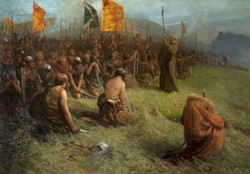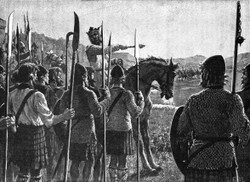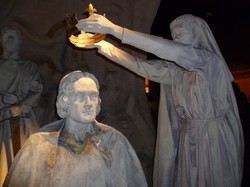Edward II was now surrounded by generals and knights whom he couldn't exactly trust. Even if they'd personally had nothing to do with the decapitation of Piers Gaveston, then they almost certainly supported the action.
The interim between then and now had been tense in the extreme. Civil war had seemed certain. English nobles and the Marcher Lords had all been straining at the bit to rise in rebellion against their anointed king.
Yet somehow Edward II had clawed it all back. The situation had simmered down far enough for his monarchy to raise the army that marched on Scotland. Robert the Bruce was right to worry about it. Battle-hardened men led well equipped troops, in numbers which far out-stripped those standing on the Scottish lines.
But the expected cohesion wasn't quite there. The cracks of the near miss civil war still showed.
For a start, the amassed English armies could have been so much bigger. Residual fury told in sullen nobles mustering only at the eleventh hour; fulfilling their feudal obligations with the smallest possible number of militia in their train.
More damaging yet was the power vacuum, which had opened up around Edward II. For decades, it had been the families with the prettiest young men which had gained prestige; now they were discovering that might, while not precisely right, could certainly bully their monarch into a grudging compliance. At least until things blew over.
At the highest level, diplomatic wranglings dogged the English army from Berwick to Bannockburn.
Stunned, and still mourning Gaveston, Edward II moved amongst them, cowed for his crown and fearing for his person. Understanding too that he rode in the shadow of his ferocious late father - Edward I, the Hammer of the Scots - and any comparisons would surely be unduly exaggerated and cruel.
Thus it's hardly surprising that, when pressed to choose a commander, Edward floundered into a compromise. It wasn't one person, but two, which jointly controlled the English vanguard across the border into Scotland. Nor were the Earls of Hereford and Gloucester precisely working together, as they rode north towards Stirling Castle.
Such fracture lines were unforeseen by the Scots, but were exploited to the utmost at the battle of Bannockburn.





















 St Tydecho's Churches in West Waleson 09/03/2014
St Tydecho's Churches in West Waleson 09/03/2014
 Goodies for an Outlander Premiere Partyon 03/06/2015
Goodies for an Outlander Premiere Partyon 03/06/2015
 Holocaust Memorial Day Interview with Rainer Höss, Grandson of Rudolf Architect of Auschwitzon 01/24/2015
Holocaust Memorial Day Interview with Rainer Höss, Grandson of Rudolf Architect of Auschwitzon 01/24/2015
 Romantic Valentine Gifts for an Outlander Fanon 01/16/2015
Romantic Valentine Gifts for an Outlander Fanon 01/16/2015



Comments
The English were largely all for taking down Edward II instead. But diplomacy dictated that they quickly dispatch this Scottish upstart (Robert the Bruce), so they could hurry off home and get on with the serious business of working out how to do with their own king.
It didn't quite work out like that.
And yes, to my mind, if the English had refused point blank to enter the Bannock Burn, then Robert the Bruce's army would have been in big trouble.
"If emotions hadn't been running so high, then the English might have refused to fight at all. It's hard to have a battle without an opposition."
So when you said the battle almost didn't happen... It's kind of funny that the English being all high strung is the reason that it did, essentially. :|
You realize that historians have been arguing about this since shortly after it happened? The safest stats are probably around 6,000 on the Scottish side, and around 16,000 on the English.
However, the Scots could well have had far fewer, and the English army has been estimated as far up as 100,000.
As somebody not very familiar with this battle, how many English were there, and how many Scottish?
I have the equally nasty suspicion that's the justification for a lot of battles. They say that war is the failure of negotiation.
It's nasty that whole wars can be fought, just because some people are in a bad mood that day.